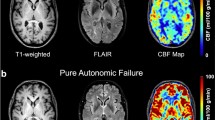Abstract.
In Fabry disease, there is glycosphingolipid storage in vascular endothelial and smooth muscle cells and neurons of the autonomic nervous system. Vascular or autonomic dysfunction is likely to compromise cerebral blood flow velocities and cerebral autoregulation. This study was performed to evaluate cerebral blood flow velocities and cerebral autoregulation in Fabry patients. In 22 Fabry patients and 24 controls, we monitored resting respiratory frequency, electrocardiographic RR-intervals, blood pressure, and cerebral blood flow velocities (CBFV) in the middle cerebral artery using transcranial Doppler sonography. We assessed the Resistance Index, Pulsatility Index, Cerebrovascular Resistance, and spectral powers of oscillations in RR-intervals, mean blood pressure and mean CBFV in the high (0.15–0.5 Hz) and sympathetically mediated low frequency (0.04–0.15 Hz) ranges using autoregressive analysis. Cerebral autoregulation was determined from the transfer function gain between the low frequency oscillations in mean blood pressure and mean CBFV. Mean CBFV (P < 0.05) and the powers of mean blood pressure (P < 0.01) and mean CBFV oscillations (P < 0.05) in the low frequency range were lower,while RR-intervals, Resistance Index (P < 0.01), Pulsatility Index, Cerebrovascular Resistance (P < 0.05), and the transfer function gain between low frequency oscillations in mean blood pressure and mean CBFV (P < 0.01) were higher in patients than in controls. Mean blood pressure, respiratory frequency and spectral powers of RR-intervals did not differ between the two groups (P > 0.05). The decrease of CBFV might result from downstream stenoses of resistance vessels and dilatation of the insonated segment of the middle cerebral artery due to reduced sympathetic tone and vessel wall pathology with decreased elasticity. The augmented gain between blood pressure and CBFV oscillations indicates inability to dampen blood pressure fluctuations by cerebral autoregulation. Both, reduced CBFV and impaired cerebral autoregulation, are likely to be involved in the increased risk of stroke in patients with Fabry disease.
Similar content being viewed by others
Author information
Authors and Affiliations
Corresponding author
Rights and permissions
About this article
Cite this article
Hilz, M.J., Kolodny, E.H., Brys, M. et al. Reduced cerebral blood flow velocity and impaired cerebral autoregulation in patients with Fabry disease. J Neurol 251, 564–570 (2004). https://doi.org/10.1007/s00415-004-0364-9
Received:
Revised:
Accepted:
Issue Date:
DOI: https://doi.org/10.1007/s00415-004-0364-9




